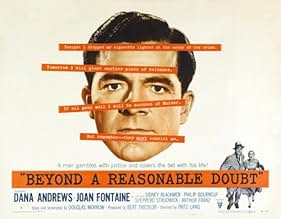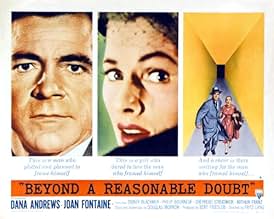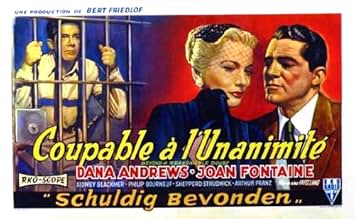IMDb RATING
6.9/10
6.3K
YOUR RATING
A novelist aided by his future father-in-law conspires to frame himself for the murder of a burlesque dancer as part of an effort to ban capital punishment.A novelist aided by his future father-in-law conspires to frame himself for the murder of a burlesque dancer as part of an effort to ban capital punishment.A novelist aided by his future father-in-law conspires to frame himself for the murder of a burlesque dancer as part of an effort to ban capital punishment.
- Awards
- 1 nomination total
William F. Leicester
- Charlie Miller
- (as William Lester)
- Director
- Writer
- All cast & crew
- Production, box office & more at IMDbPro
Featured reviews
Sometimes, in the world of 1940s-1950s film noir, we are given a film so transparently impossible and contrived that we can see ourselves giving up on watching it half way through. But is extremely rare that we are faced with a film where the very response the viewer is having holds the key to the success, rather than the failure, of the film.
Such is the case with BEYOND A REASONABLE DOUBT, which has - to its credit - been completely misunderstood by many. When we reach the film's conclusion, we realize that even the title of the film itself is a joke, perhaps the ultimate prank on the viewer. Yet to offer analysis of the film would be to destroy its main and most sinister motive; you can't "explain away" the glaring plot holes and contrivances without revealing the twist the film takes in its climax, and to do would rob the viewer of a genuine experience. So... I won't.
Suffice it to say, BEYOND A REASONABLE DOUBT is far more than it seems and is nothing without the sum of its parts, in total. Lang tackles the story of a person who creates a fictitious role for himself in order to, essentially, pull a fast one on the legal profession for personal gain (or, as it appears on the surface, someone else's). In the world of film noir, of course, we know that such a character won't get away with it, but when Lang depicts the tragedy the viewer knows will come, he majestically turns the entire premise on its head. As a result, it's a cold slap in the face - a devastating critique of the complicity of the audience in following along, hungrily, with such contrivances in cinema.
Every part of the film fits perfectly by not fitting at all. Even the visual style of the film is a cold, rarely pleasing one, almost daring you to suspend your disbelief just a little bit longer without even granting the pleasure of emotionally charged close-ups at key moments. The editing is brutal and jarring, cutting away practically mid-sentence and moving to a similar conversation elsewhere.
As a swan song to his Hollywood career, BEYOND A REASONABLE DOUBT does to the audience what Billy Wilder does to the industry in SUNSET BLVD. - biting the hand that feeds. The result is a total masterpiece.
Such is the case with BEYOND A REASONABLE DOUBT, which has - to its credit - been completely misunderstood by many. When we reach the film's conclusion, we realize that even the title of the film itself is a joke, perhaps the ultimate prank on the viewer. Yet to offer analysis of the film would be to destroy its main and most sinister motive; you can't "explain away" the glaring plot holes and contrivances without revealing the twist the film takes in its climax, and to do would rob the viewer of a genuine experience. So... I won't.
Suffice it to say, BEYOND A REASONABLE DOUBT is far more than it seems and is nothing without the sum of its parts, in total. Lang tackles the story of a person who creates a fictitious role for himself in order to, essentially, pull a fast one on the legal profession for personal gain (or, as it appears on the surface, someone else's). In the world of film noir, of course, we know that such a character won't get away with it, but when Lang depicts the tragedy the viewer knows will come, he majestically turns the entire premise on its head. As a result, it's a cold slap in the face - a devastating critique of the complicity of the audience in following along, hungrily, with such contrivances in cinema.
Every part of the film fits perfectly by not fitting at all. Even the visual style of the film is a cold, rarely pleasing one, almost daring you to suspend your disbelief just a little bit longer without even granting the pleasure of emotionally charged close-ups at key moments. The editing is brutal and jarring, cutting away practically mid-sentence and moving to a similar conversation elsewhere.
As a swan song to his Hollywood career, BEYOND A REASONABLE DOUBT does to the audience what Billy Wilder does to the industry in SUNSET BLVD. - biting the hand that feeds. The result is a total masterpiece.
While Sidney Blackmer and Dana Andrews cook up and carry out their scheme to prove that an innocent person can be convicted of a murder, everyone ignores the fact that, by getting this innocent person convicted, they're helping the real murderer escape justice. Just sayin'.
Tom Garrett is a writer engaged to the daughter of wealthy newspaper man Austin Spencer. Spencer is also firmly against the death penalty. With Tom looking for a subject for a second novel, Spencer suggests that they set Tom up for an unsolved murder using circumstantial evidence to prove how easy it would be for the courts to kill an innocent man. Once Tom is sentenced to the chair, Spencer will expose the failings in the system and free him. However when Spencer is killed in car crash and none of the evidence can be found then Tom faces the chair.
A very interesting concept still needs a good delivery to make for a good film. This not only had a good idea but it was also a fair point to be made about the death penalty. The film moves along with a good build up for the whole first half. However once Tom finds himself in real trouble then the film strangely doesn't manage to deliver as much tension as it really should have done. Conversely the film becomes more of a melodrama for a while and it loses a lot of momentum. There are some nice touches at the end but they can't completely make up for the weaknesses in the middle section.
It is quite atmospheric but not to the point that I had hoped but Lang does a good job on direction. The cast are OK. Andrews has long been one of my favourite actors from the period and he gives a solid if unspectacular show here. Fontaine is weaker and doesn't quite convince as well as Andrews but is fine. Blackmer is pretty enjoyable as Austin Spencer and Ed Binns is a familiar face as Lt. Kennedy.
It doesn't quite work as you'd hope as the tension drops off at the exactly the moment that it needs to step up a notch. It is worth watching but it is not one of Lang's better films.
A very interesting concept still needs a good delivery to make for a good film. This not only had a good idea but it was also a fair point to be made about the death penalty. The film moves along with a good build up for the whole first half. However once Tom finds himself in real trouble then the film strangely doesn't manage to deliver as much tension as it really should have done. Conversely the film becomes more of a melodrama for a while and it loses a lot of momentum. There are some nice touches at the end but they can't completely make up for the weaknesses in the middle section.
It is quite atmospheric but not to the point that I had hoped but Lang does a good job on direction. The cast are OK. Andrews has long been one of my favourite actors from the period and he gives a solid if unspectacular show here. Fontaine is weaker and doesn't quite convince as well as Andrews but is fine. Blackmer is pretty enjoyable as Austin Spencer and Ed Binns is a familiar face as Lt. Kennedy.
It doesn't quite work as you'd hope as the tension drops off at the exactly the moment that it needs to step up a notch. It is worth watching but it is not one of Lang's better films.
For his final Hollywood film, Fritz Lang decided to expose the pitfalls of capital punishment for circumstantial evidence. For this film, Lang has kept it simple; with the entire movie focusing on the central premise and not a lot of anything else going on. Filmmakers can sometimes saturate a film with lots of sub-plots, and it can have a huge detrimental effect on what the film is trying to achieve. By keeping it simple, Lang gives himself time to fully explore the implications of his plot and the film is made more compelling because of this. The story follows Austin Spencer; a person of stature that is continually campaigning against circumstantial evidence being used as a means to send someone to the electric chair. His efforts are unsuccessful, until he has the bright idea to have a man sent to death row on circumstantial evidence, only to be pardoned at the last minute by means of the evidence to prove his innocence being brought to light. Enter Tom Garrett; Austin's son in law to be, and the man that agrees to frame himself for murder...
This is perhaps Lang's best assault on the American justice system; he has created a story that is interesting and very plausible and it works a treat in that it gets you thinking about the fact that with this kind of law; someone really could be killed for something they didn't do. Of course, the chances of someone risking being put to death to expose this are unlikely, but then again; it's only a movie, so you can expect to suspend your belief a little for a point to be made. Beyond a Reasonable Doubt also features one of the most finely tuned plot twists that I've seen in a movie. Lang shows us everything about the plot; from the first ideas, to the setting up, all the way to the trial and because of this; the final twist comes as a complete surprise. It's been done and done a million times since this film, but despite this; Beyond a Reasonable Doubt still has the power to shock the viewer.
Beyond a Reasonable Doubt is one of the highlights of Lang's illustrious filmography. It has an unfairly low IMDb rating, and I hope that you will not use that as a means of deciding whether or not to see this film. It is efficient story telling at it's best and this is one of the highlights of the film noir era.
This is perhaps Lang's best assault on the American justice system; he has created a story that is interesting and very plausible and it works a treat in that it gets you thinking about the fact that with this kind of law; someone really could be killed for something they didn't do. Of course, the chances of someone risking being put to death to expose this are unlikely, but then again; it's only a movie, so you can expect to suspend your belief a little for a point to be made. Beyond a Reasonable Doubt also features one of the most finely tuned plot twists that I've seen in a movie. Lang shows us everything about the plot; from the first ideas, to the setting up, all the way to the trial and because of this; the final twist comes as a complete surprise. It's been done and done a million times since this film, but despite this; Beyond a Reasonable Doubt still has the power to shock the viewer.
Beyond a Reasonable Doubt is one of the highlights of Lang's illustrious filmography. It has an unfairly low IMDb rating, and I hope that you will not use that as a means of deciding whether or not to see this film. It is efficient story telling at it's best and this is one of the highlights of the film noir era.
In his last film in the USA before returning to Germany where he had left to escape the Nazis in the Thirties, Fritz Lang takes up the case of capital punishment and its application, especially when the case is a circumstantial one.
Unlike the remake of Beyond A Reasonable Doubt with Jesse Metcalfe as the reporter and Michael Douglas as a corrupt District Attorney, both Sidney Blackmer as a newspaper publisher and Sheppard Strudwick as the politically ambitious DA hold each other in respect. Blackmer is not happy with Strudwick running up a string of murder convictions as a platform to be governor.
He and prospective son-in-law Dana Andrews agree to frame Andrews with a string of manufactured evidence all carefully documented with photographs to have the police arrest him for murder of a burlesque queen that the police are stumped about. It certainly works all right, but as the case is coming to verdict, Blackmer is killed in an automobile accident and the evidence burn with him. Andrews is left in quite the jackpot.
How it all works out is for you to see. Andrews is not abandoned by fiancé Joan Fontaine who is Blackmer's daughter. She does what she can and toward the end of the film her performance dominates.
Fritz Lang certainly builds the tension worthy of Alfred Hitchcock himself. One scene did have me baffled. After the police have gotten those arranged clues, Andrews makes some moves on burlesque dancer Barbara Nichols who resists his advances. I could not quite believe that one at all.
This original version is a notch or two above the Metcalfe/Douglas remake. Though it got an interesting alternative remake, this is still the one to see.
Unlike the remake of Beyond A Reasonable Doubt with Jesse Metcalfe as the reporter and Michael Douglas as a corrupt District Attorney, both Sidney Blackmer as a newspaper publisher and Sheppard Strudwick as the politically ambitious DA hold each other in respect. Blackmer is not happy with Strudwick running up a string of murder convictions as a platform to be governor.
He and prospective son-in-law Dana Andrews agree to frame Andrews with a string of manufactured evidence all carefully documented with photographs to have the police arrest him for murder of a burlesque queen that the police are stumped about. It certainly works all right, but as the case is coming to verdict, Blackmer is killed in an automobile accident and the evidence burn with him. Andrews is left in quite the jackpot.
How it all works out is for you to see. Andrews is not abandoned by fiancé Joan Fontaine who is Blackmer's daughter. She does what she can and toward the end of the film her performance dominates.
Fritz Lang certainly builds the tension worthy of Alfred Hitchcock himself. One scene did have me baffled. After the police have gotten those arranged clues, Andrews makes some moves on burlesque dancer Barbara Nichols who resists his advances. I could not quite believe that one at all.
This original version is a notch or two above the Metcalfe/Douglas remake. Though it got an interesting alternative remake, this is still the one to see.
Did you know
- TriviaFinal American film made by Fritz Lang before returning to Germany. It was a box-office failure.
- GoofsWHile the trial is shown on TV there is a frontal shot of Tom sitting at the defendants desk. This would not be possible as the television camera was stationed behind and to the side of the desk. It's not feasible that the large 1950's era television camera would have been moved to the front of the courtroom for the shot.
- Quotes
Tom Garrett: Well, could I get in touch with you?
Dolly Moore: You've touched enough already!
- ConnectionsFeatured in Propriété privée (1960)
- SoundtracksBeyond A Reasonable Doubt
Sung by The Hi-Los (as The Hi-Lo's)
Music by Herschel Burke Gilbert
Lyrics by Alfred Perry
- How long is Beyond a Reasonable Doubt?Powered by Alexa
Details
- Release date
- Country of origin
- Language
- Also known as
- Invraisemblable vérité
- Filming locations
- Chicago, Illinois, USA(location shooting)
- Production company
- See more company credits at IMDbPro
- Runtime
- 1h 20m(80 min)
- Color
Contribute to this page
Suggest an edit or add missing content






























